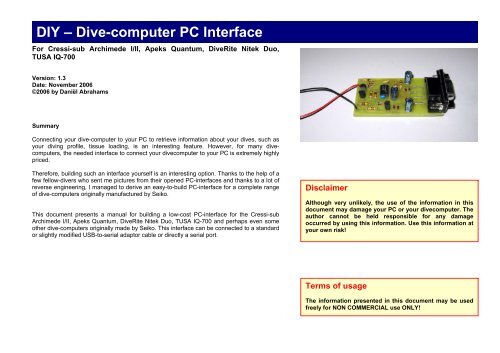In the past, manufacturers provided a serial (RS-232) interface to download data from their dive computers. Nowadays, recent systems do not have serial ports anymore, and almost all manufacturers have switched to USB interfaces. In contrast to the legacy serial interfaces, these cables require a driver to operate.
On Windows systems, you can simply install the drivers that are provided with the Windows application.
All content included as part of this site, such as texts, logos, graphics is the property of Cressi Sub S.p.A. P.IVA IT4 powered. Dec 19, 2019 The driver is named: usbaudio2.sys and the associated inf file is usbaudio2.inf. The driver will identify in device manager as 'USB Audio Class 2 Device.' This name will be overwritten with a USB Product string, if it is available. The driver is automatically enabled when a compatible device is attached to the system. Fix USB Drivers using Device manager. View our post on fixing USB Driver issues in Windows 8. Go to Menu Run; Type device manager in the text box; Select Device Manager; Find Universal Serial Bus controllers and expand the list; Right-click Unknown Device; Select Properties from the context-sensitive menu; Select Drivers; Click Update Driver. USB Composite and related drivers. Quectel HighSpeed USB Composite Device Driver 5.0.1.3 for Windows 10 Creators Update 64-bit 118 downloads. Motherboard Other. Windows 10 64 bit. Mar 4th 2018, 22:54 GMT. Quectel HighSpeed USB Composite Device Driver 5.0.1.3 for Windows.
On Linux and Mac OS X, the situation is more complicated because most manufacturers do not provide a driver for non-Windows systems. However, most USB interfaces contain a serial-to-usb chip from one of the companies listed below, and you can obtain a driver from their website. Note that some Linux distributions or Mac OS X systems, already have these drivers included by default.
- FTDI (driver)
- Silicon Labs CP210x (driver)
- Prolific PL-2303 (driver)
In some cases, the generic driver from the chip manufacturer does not recognize the USB interface automatically and you need to perform some additional steps.
| Manufacturer | VID | PID |
|---|---|---|
| FTDI | 0x0403 | 0x6001 |
| Heinrichs-Weikamp | 0x0403 | 0x6001 |
| Ratio | 0x0403 | 0x6015 |
| Oceanic | 0x0403 | 0xF460 |
| Suunto | 0x0403 | 0xF680 |
| Suunto (Smartinterface) | 0x0403 | 0x6001 ? 0x6010 ? 0x6011 ? |
| Cressi (leonardo) | 0x0403 | 0x87D0 |
| Silicon Labs | 0x10C4 | 0xEA60 |
| Suunto (CustomIdea) | 0x10C4 | 0xEA60 |
| Mares | 0x10C4 | 0xEA60 |
| Prolific | 0x067B | 0x2303 |
| Reefnet | 0x067B | 0x2303 |
| Mares (Nemo Sport) | 0x04B8 | 0x0521 |
| Cressi | 0x04B8 | 0x0521 |
| Zeagle | 0x04B8 | 0x0522 |
| Freescale Semiconductor | ? | ? |
| Mares (Icon HD) | 0xFFFF | 0x0005 |
Suunto
The FTDI driver is included in the Linux kernel. The device node (usually /dev/ttyUSBx) will appear automatically once you plug in the USB cable.
Pelagic (Oceanic, ...)
The standard FDTI driver works just fine, but the custom Oceanic VID/PID (Vendor ID/Product ID) is not recognized automatically.

Linux

You need to load the driver manually, by executing the following command (as root):
To make the change permanent, you can add the parameters to the file /etc/modprobe.d/options (or modify the source code and recompile the driver, but that is beyond the scope of this document):
An alternative approach for binding the Oceanic VID/PID to the FTDI driver is executing the following command (as root):
Mac OS X
Note: The latest FTDI driver (version 2.2.14 or higher) recognizes the Oceanic cable automatically and the procedure below is not necessary anymore.

Follow these steps to make the FTDI driver recognize the Oceanic cable:
- Locate the file /System/Library/Extensions/FTDIUSBSerialDriver.kext/Contents/Info.plist
- Alter the permissions to make it writeable, but BE SURE TO SET THEM BACK EXACTLY THE SAME AFTER YOU'RE DONE
- Open it, and search for 'Oceanic'. You'll find a Pelagic Oceanic entry (which is apparently something else). Change the idProduct from 62566 to 62560.
- Save, quit and restore the permissions.
- Reload the driver by running the following commands (as root):
Seiko (Cressi, Zeagle, ...)
The standard Prolific driver works just fine, but the custom Cressi VID/PID (Vendor ID/Product ID) is not recognized automatically.
Windows
Drivers Cressi USB Devices
Update: More detailed instructions are available here.
The Cressi software installs a USB only driver that does not provide a serial interface. Follow this procedure to modify the generic prolific driver to work with the Cressi interface.
- Download and install the generic pl2303 driver from the Prolific website.
- After installing the driver, a new oemXX.inf file (with XX being the last number available) will appear under c:windowsinf.
- Open this file and substitute the original vid/pid (067b 2303) with the 'new' ones (04b8 0521).
- After saving the file, the interface gets recognized as a standard pl2303 usb-to-serial interface.

Note that it's not possible to have two drivers installed for the same device. You'll have to uninstall the usb only driver first. You can always re-install it again.
Linux
Use the Oceanic procedure, with this command (as root):
Replace PID with 0521 (cressi) or 0522 (zeagle).
Drivers Cressi Usb Devices Adapter
Mac OS X
Update: I made a bash script to automate the driverpatching. Download the script, start a terminal and runthe command: sudo bash seiko.sh The sudo command is to runthe script with root priviliges. You'll have to enter your password whenasked.
Use the Pelagic procedure.
The Prolific driver you need to modify is named 'ProlificUsbSerial.kext'. Search for the keys idVendor and idProduct, and change the idVendor value from 1659 to 1208, and the idProduct value from 8963 to 1313 (cressi and mares) or 1314 (zeagle).
